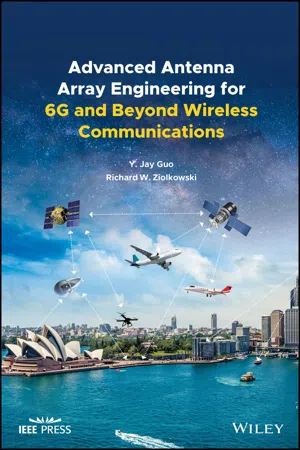
Advanced Antenna Array Engineering for 6G and Beyond Wireless Communications
Yingjie Jay Guo, Richard W. Ziolkowski
- English
- ePUB (mobile friendly)
- Available on iOS & Android
Advanced Antenna Array Engineering for 6G and Beyond Wireless Communications
Yingjie Jay Guo, Richard W. Ziolkowski
About This Book
Advanced Antenna Array Engineering for 6G and Beyond Wireless Communications
Reviews advances in the design and deployment of antenna arrays for future generations of wireless communication systems, offering new solutions for the telecommunications industry
Advanced Antenna Array Engineering for 6G and Beyond Wireless Communications addresses the challenges in designing and deploying antennas and antenna arrays which deliver 6G and beyond performance with high energy efficiency and possess the capability of being immune to interference caused by different systems mounted on the same platforms. This timely and authoritative volume presents innovative solutions for developing integrated communications networks of high-gain, individually-scannable, multi-beam antennas that are reconfigurable and conformable to all platforms, thus enabling the evolving integrated land, air and space communications networks.
The text begins with an up-to-date discussion of the engineering issues facing future wireless communications systems, followed by a detailed discussion of different beamforming networks for multi-beam antennas. Subsequent chapters address problems of 4G/5G antenna collocation, discuss differentially-fed antenna arrays, explore conformal transmit arrays for airborne platforms, and present latest results on fixed frequency beam scanning leaky wave antennas as well as various analogue beam synthesizing strategies. Based primarily on the authors' extensive work in the field, including original research never before published, this important new volume:
- Reviews multi-beam feed networks, array decoupling and de-scattering methods
- Provides a systematic study on differentially fed antenna arrays that are resistant to interference caused by future multifunctional/multi-generation systems
- Features previously unpublished material on conformal transmit arrays based on Huygen's metasufaces and reconfigurable leaky wave antennas
- Includes novel algorithms for synthesizing and optimizing thinned massive arrays, conformal arrays, frequency invariant arrays, and other future arrays
Advanced Antenna Array Engineering for 6G and Beyond Wireless Communications is an invaluable resource for antenna engineers and researchers, as well as graduate and senior undergraduate students in the field.
Frequently asked questions
Information
1
A Perspective of Antennas for 5G and 6G
1.1 5G Requirements of Antenna Arrays
1.1.1 Array Characteristics
- a) Diversity and Diversity Combining
- b) Spatial Multiplexing
- c) Beamforming